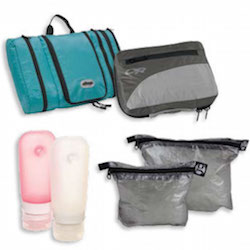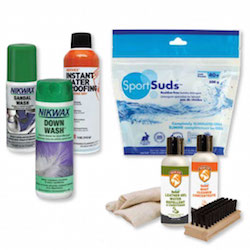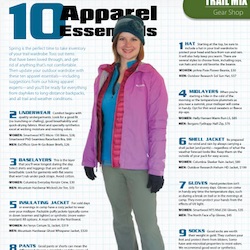Time for Spring Cleaning
Written for Washington Trails magazine
Visit the published article here and the companion blogs here
There are many things to love about spring: warmer temperatures, longer days and the sweet promise of another hiking season just around the corner. But before you hit the trail, it’s time for some good old-fashioned spring cleaning.
Don’t know where to start? It’s as easy as one, two, three.
One: Reorganize | Two: Refresh | Three: Restock
 Reorganize Your Gear
Reorganize Your Gear
Small Items
Don’t let your matches or your toothbrush get lost in your pack—give them a home. Here are some of our favorite organizers for everything from toiletries to odds and ends.
Toiletries: Tired of trying to squeeze the last bit of ecofriendly shampoo out of too-stiff travel containers? Switch to the ultra-malleable humangear GoToob. The multipack ($22) contains three 2 oz. bottles that are perfect for everything from wilderness wash to contact solution. They also fit nicely inside the Outdoor Research Backcountry Organizer ($30), our favorite ultralight kit that’s heavy on both zippered compartments and handy pockets. (Pro tip: The Backcountry Organizer isn’t just for toiletries. We also used it to organize electronics and camping knickknacks.) For car camping, try the eBags Pack-it-Flat Toiletry Kit ($30). It’s the Cadillac of bags, with an expansion slot, plastic-lined outer compartment (handy for wet items) and hook for hanging.
Odds and Ends: Organizing small essentials like fire-starters and snacks is simple with a new generation of ultralight and ultra-tiny bags. Some, like Sea to Summit Travelling Light Mini Stuff Sacks ($23, perfect for a compact first aid kit) and Granite Gear Air Zippdittys ($15, great for storing undies and socks), are ultra-colorful to keep them from getting lost in your bag and to help you colorcode your gear. Others are water-resistant, like Gossamer Gear Ultralight Ditty Bags ($16, Q-Series). But they all have something in common besides their small size—they’re tough. Although they feel as thin as paper, these three bags floated around in our packs for weeks on end and held up incredibly well.
Large Items
Once your small items are packed away, it’s time to tackle the large ones: clothes, rain gear and camp footwear. For these, stuff sacks and packing cubes are the way to go.
Stuff Sacks: Mesh stuff sacks have long been a favorite of hikers because of their see-through and lightweight construction. These days they’re better— and stronger—than ever, especially Sea to Summit Ultra-Mesh Stuff Sacks ($10), which are the most durable stuff sacks we tested, thanks to 15-denier multifilament nylon and double-stitched seams. If you’d like to store your large items in a waterproof organizer, try the SealLine Eco See Dry Bag ($20). It comes in different sizes. The small one is perfect for electronics and maps; the large one can line the inside of your backpack. For the best of both worlds—the light weight and small footprint of a stuff sack and the waterproof protection of a dry bag—check out Hyperlite Mountain Gear’s Large Cuben Stuff Sack ($24). It has enough space for a two-day food supply or a summer sleeping bag.
Packing Cubes: Sometimes it can be nice to have a little more structure for your packing solutions—and trust a zipper over a drawstring. When that’s the case, go for the Eagle Creek Pack-It Specter Cube Set ($38) or Lewis N. Clark FeatherLight Expandable Packing Cubes ($20). Both come in different sizes, have handles at the top for easy extraction from your bag and collapse down small. The Lewis N. Clark packing cubes go one step further by offering an expansion compartment. An extra bonus with packing cubes: they also work nicely in a suitcase during travel.
For sidebars, see published version of article.
 Refresh Your Favorite Items
Refresh Your Favorite Items
Keeping your gear clean and in good repair can mean the difference between using the same gear for years and having to replace it every season. But not all materials can be cared for in the same way. Here’s the down and dirty on keeping it all—from sleeping bags to tents to boots—clean.
Packs and Athletic Gear: Most outdoor gear and apparel should be washed with a detergent-free wash, not regular laundry soap. Sport Suds ($22) is formulated to restore factory-applied water repellents and eliminate odors—all without harsh chemicals or fabric softeners that can clog the breathability of high-tech materials.
Down Sleeping Bags and Puffies: The more dirt and skin oils your sleeping bag or puffy are exposed to, the heavier and less insulating they become. Using Nikwax Down Wash (not regular laundry detergent; $10) can remove problematic residues, as well as revitalize your expensive down items.
Leather Boots: Leaving mud and dirt on your leather hiking boots is more than unsightly. It’s also damaging—it draws out important oils that keep your shoes pliable. The solution is Gear Aid’s ReviveX Leather Boot Care Kit ($15) which cleans boots and restores their natural moisture.
Sandals: If your camp sandals are getting smelly, don’t chuck them. Instead, treat them with Nikwax Sandal Wash ($7). It’s designed to remove dirt and body oil buildup that leads to bacterial growth and unpleasant odors.
Waterproofing: Over time, and through contact with skin oils and chemicals from sunscreen and bug spray, all waterproof fabrics lose their mojo. Bring back that just-like-new water beading to your gear with Gear Aid ReviveX Instant Waterproofing Spray ($10), good for everything from tents to shoes to clothes.
For sidebars, see published version of article.
 Restock with 10 Apparel Essentials
Restock with 10 Apparel Essentials
Spring is the perfect time to take inventory of your trail wardrobe. Toss out items that have been loved through, and get rid of anything that’s not comfortable. Then update your outdoor wardrobe with these ten apparel essentials—including suggestions from our hiking apparel experts—and you’ll be ready for everything from dayhikes to long-distance backpacks, and all trail and weather conditions.
1. Hat
Starting at the top, be sure to include a hat in your trail wardrobe to protect your head and face from sun and rain. It will also help keep you warm. There are several styles to choose from, including caps, sun hats and our old favorite: the beanie.
- WOMEN: prAna Pixie Flower Beanie, $30
- MEN: Outdoor Research Sol Sun Hat, $37
2. Underwear
Comfort begins with quality undergarments. Look for a good fit (no bunching or chafing), good breathability and quick-drying fabrics. Wool and specialty synthetics excel at wicking moisture and resisting odors.
- WOMEN: Smartwool NTS Micro 150 Bikini, $28; Smartwool PhD Seamless Racerback Bra, $60
- MEN: ExOfficio Give-N-Go Boxer Briefs, $26
3. Baselayers
This is the layer that you’ll wear longest during the day. Select shirts and leggings that are soft and breathable. Look for garments with flat seams that won’t rub under pack straps. Avoid cotton.
- WOMEN: Columbia Everyday Kenzie Crew, $30
- MEN: Mountain Hardwear Wicked Lite Tee, $35
4. Midlayers
When you’re starting a hike in the cold of the morning or the temperature plummets as you near a summit, your midlayer will come in handy. Opt for thin wool sweaters or fleece zip-ups.
- WOMEN: Helly Hansen Warm Run LS, $85
- MEN: Bergans Fjellrapp Half-Zip, $70
5. Insulating Jacket
For cold days or evenings in camp have a cozy jacket to wear over your midlayer. Packable puffy jackets typically come in down (warmer and lighter) or synthetic (more water-resistant) fill options. A must-have in the Northwest.
- WOMEN: Arc’teryx Cerium SL Jacket, $319
- MEN: Mountain Hardwear Ghost Whisperer Jacket, $320
6. Shell Jacket
Be prepared for wind and rain by always carrying a shell jacket (and pants)—regardless of what the weather forecast looks like. Keep them on the outside of your pack for easy access.
- WOMEN: Columbia Sleeker Rain Jacket, $80
- MEN: Outdoor Research Helium HD Jacket, $199
7. Gloves
Hand protection isn’t only for snowy days. Gloves can come in handy any time the temperature dips, such as during a break on trail or in the evenings at camp. They even protect your hands from the effects of UV light.
- WOMEN: Smartwool NTS Mid 250 Gloves, $35
- MEN: The North Face eTip Gloves, $45
8. Pants
Good pants or shorts can mean the difference between a great hike and the agony of chafing. Buy bottoms with enough flexibility and extra room to move comfortably down the trail, lunge over small streams and climb big rocks.
- WOMEN: Mountain Hardwear Dynama Pant, $70
- MEN: prAna Stretch Zion Convertible Pant, $85
9. Socks
Good socks are worth their weight in gold. They cushion your feet and protect them from blisters. Some have anti-microbial properties to resist odors. We recommend good wool or synthetics.
- WOMEN: Darn Tough Solid ¼ Cushion, $17
- MEN: Thorlo Trail Hiking Socks, $17
10. Boots
Good footwear provides stability for your ankles and protects your feet from rocks, branches and moisture. Look for breathability, water repellency and comfort. And always break in your boots before a long hike.
- WOMEN: The North Face Ultra Fastpack GTX, $140
- MEN: Lowa Renegade GTX, $230


